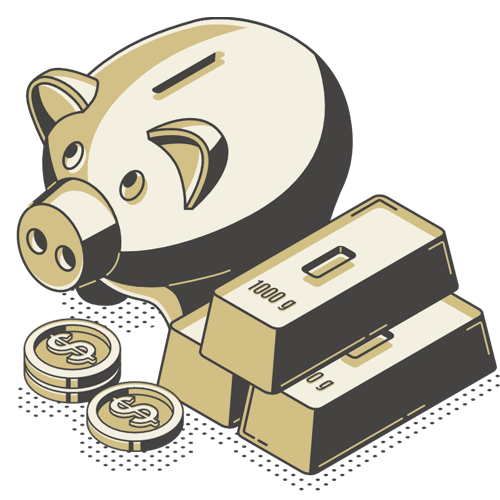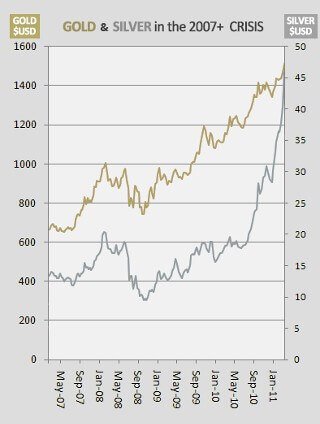
Asset values are incredibly volatile today, reflecting the continuing global presence of COVID, political tensions of armed conflict in the Ukraine, shattered trade relations, and renewed pressure on the dollar as the world's reserve currency. Traditional investments – stocks and bonds – are especially vulnerable to sharp declines as fear grips communities across the globe. As such, opening a precious metals IRA makes smart financial sense.
The chaotic conditions impose new risks for investors anxious to protect their retirement assets.
The banks and brokerage houses that functioned as trustees specialized in stocks, bonds, and mutual funds and had little incentive to expand investment choices.
Diversification
“Diversification is a protection against ignorance,” according to Warren Buffett.
While a pithy statement, it makes little sense in the real investment world unless you have Buffett's net worth ($126 billion). It is also misleading as his Berkshire Hathaway portfolio contained the securities of more than twenty companies in March 2022.[i] Buffett presumes that knowing the future of a company is possible with enough accurate information, proper analysis, and studious effort.

Nevertheless, he admitted to his shareholders at the 2020 online annual meeting that “there's no way to predict the economic future right now because the possibilities are still too varied.” [ii] At the time of his comments, events including fractured global supply lines, the invasion of Ukraine, and the rise of oil to more than $100 per barrel were not predicted and had not occurred.
Diversification is the universal strategy to spread unavoidable risk to minimize its impact if the event occurs. The idiom “Don't put your eggs in one basket” and similar expressions have been repeated for generations. The meaning is clear: Using several baskets eliminates the possibility of losing your eggs if you drop one basket.
Applied to investing, owning different assets avoids a total loss that might occur to a single investment. True diversification requires a portfolio of various holdings with offsetting investment characteristics. While owning a mutual fund is less risky than owning a single company's stock, even mutual funds lose value in bear markets. A more prudent approach in times of uncertainty requires owning multiple assets and asset types that react differently in times of financial stress.
Hedging
“Hedging” is a form of diversification specifically designed to protect the total portfolio value—a hedge functions like a children's seesaw. When one end drops to the ground, the other end rises in the air. When risks are perfectly balanced, the seesaw is level.
For centuries, during uncertainty, gold has been the preferred “safe haven” for investors. The limited supply of the yellow metal makes it an ideal asset to retain purchasing power in periods of inflation, bear markets, or currency collapse. The price of gold (and other precious metals) tends to rise when economies contract or securities markets tremble.
Precious Metals Investment
Gold and silver were the substance of early currency. King Croesus of Lydia first coined gold between 600-500 BCE.
Due to its color, relative rarity, malleability, and low reactivity, gold was particularly favored for coins and is one of a group scientists call the “noble metals.”
Coins with a market value greater than their face value are considered “collectibles” and prohibited as investments in IRS tax-advantaged accounts.
Four members of the precious metals group with minimum purities of 99.95% (gold, platinum, palladium) or 99.9% (silver) can be purchased and held in a self-directed gold IRA account.

The price for which a precious metal trades is a function of investor and industrial demand versus available supply. For example, platinum is rarer than gold, while palladium is rarer than platinum. South Africa is the primary source of platinum. Russia is the largest producer of palladium. International trade tensions increase the volatility of both metals more than gold and silver.
Precious Metals in a Self-Directed IRA
An IRA is often the primary source of an individual's retirement savings. Most individuals establish IRAs with limited investment opportunities and allow others to make investment decisions despite their importance. According to the Investment Company Institute, full-service brokerage houses, mutual funds, financial planning firms, banks, and insurance companies manage three-quarters of traditional IRAs.[iii] As a consequence, account holders are unable to diversify their nest eggs into real estate, private companies, or precious metals.
- “Real” Diversification to Reduce Market Risk
Self-Directed Traditional and Roth IRAs offer investors the same tax advantages and the same opportunities to use investment advisers as a typical IRA, plus the benefit of diversifying into alternative asset types like gold.
- Greater Control Over Account
The account owner of a self-directed account manages the account and makes investment decisions. While self-directed IRAs require you to utilize the services of a third party by law – often referred to as a custodian or trustee – the owner retains the freedom to direct or delegate investment decisions to an outside adviser for any portion of the account or remove an adviser at any time. The account owner decides the composition of their portfolio and can revise or update it at any time in the future, complying with laws and contracts they sign.
- Greater Flexibility in Investments
A self-directed IRA gives the account owner more choices in the investments you can hold in the IRA. For example, one account holder might direct 20% of the funds into physical gold and the remaining 80% into a favorite mutual fund. Another account holder might prefer a 15% position in gold, 10% in a private company, and 75% in a mutual fund. The account trustee agreement will specify limitations on investment choices.
Opening a Precious Metals Self-Directed IRA

Opening a precious metals self-directed IRA shouldn't be difficult, expensive, or time-consuming. America's top gold ira companies reviewed on this website are ready to help you complete the forms and guide you through the following steps online:
-
Select the Type of Gold for the Account. The permitted investments in your IRA are either bullion in the form of bars or rounds or specific minted coins of 99.5% purity. Allowable coins include one, one-half, one-quarter, and one-tenth-ounce gold coins minted by different countries. Your chosen precious metals specialist can help you select the most suitable approved gold type for you.
-
Determine Funding Source. The funds for your gold IRA may be the result of a rollover (transfer) from an existing 401(k), 401(a), 403(b), 457, Thrift Savings Plan (TSP), or an annuity. Many people elect to open and fund a new IRA. There is no limit on the number of IRAs an individual might have. However, the total contribution to all must be no more than the maximum allowed by law (up to $6,000 in a traditional IRA or $7,000 for a person over 50). Your chosen precious metals specialist will explain the various options so that you select the one most appropriate for your retirement.
-
Select Qualified Trustee/Custodian. Per IRS regulations, an approved, qualified custodian must hold the assets in an IRA for the benefit of the account owner. While your selected trustee/custodian must be familiar with the purchase and storage of gold investments, they do not provide investment advice. Trustee/custodians charge annual fees for their storage, insurance, and administration services, a consideration when choosing the custodian best suited to your requirements.
-
Fund the Gold IRA. By law, the trustee/custodian must purchase gold investments in your IRA to maintain its tax advantages. You may deposit the funds through a rollover from an existing retirement account or directly as the account owner. You must follow specific rollover conditions to avoid a taxable event. Your precious metals specialist will be available to guide you through the process and avoid potential difficulties.
-
Purchase the Selected Gold Type. After funding the account, the account owner directs the trustee/custodian to purchase the gold from a designated dealer. The dealer then directly delivers the gold in the specified form to the trustee/custodian for storage.
Final Thoughts
Current events continue to escalate world tensions and affect all aspects of everyday life. Gasoline prices in the U.S. have risen over $6.00 per gallon on the West Coast. The Federal Reserve has announced the probability of more interest rate hikes soon. Global supply chains are in disarray. The settlement of the Russian/Ukraine war is not in sight, nor the position of China in the dispute. With of all of these factors in play, as well as their potential unforeseen consequences, opening a precious metals IRA makes smart financial sense.
Investments of all types are affected, with negative and positive impacts. A wise man once said, “When elephants dance, it's time to get off the dance floor.” The economic and political forces at play today are indeed elephants with the possibility of wrecking the dancehall.
Precious metals are proven to be a sought-after commodity in perilous times. Your chosen precious metals specialist can help you diversify with gold and other precious metals.